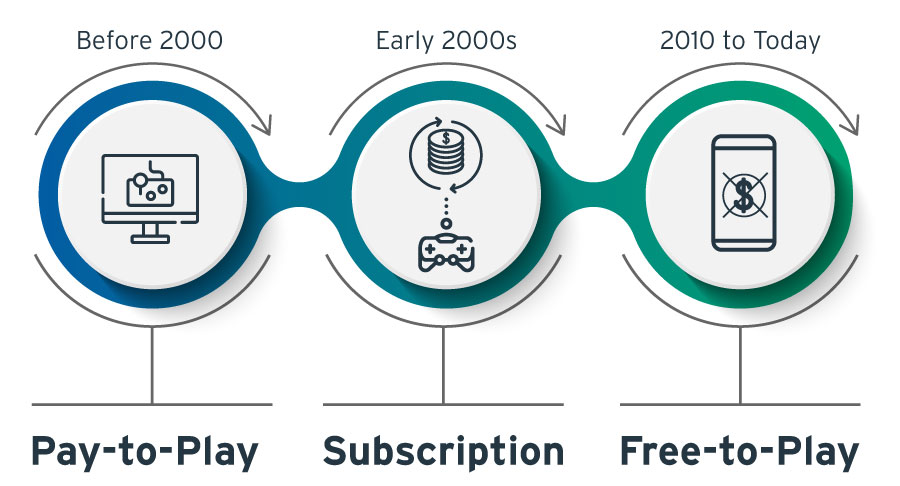Online Gaming: Gateway to the Metaverse

In the age of COVID-19, video games are big business: global gaming sales hit $175B in 2020, more than the North American music and box office industries combined.
Many of the online multiplayer games driving this growth, such as Minecraft, Fortnite, and Roblox, are as much or more about the community built in or around the game as they are about playing the game itself. Games like these often allow players to create personalized avatars, socialize in virtual spaces, transact in some equivalent to digital currencies, and more. These games can therefore be thought of as precursors to the emerging concept of Metaverses built around digital assets and non-fungible tokens (NFTs).
But how and when did video games go from being niche entertainment to the foundations of disruptive new virtual economies? And what does their evolution suggest about the future of our digital lives? In this article, we will walk through the history of gaming—next, we’ll delve into its implications for the finance industry.
Video Game Monetization Through the Years
Gaming has come a long way since the days of coin-based video arcades, as has its economics.
Historically, most games have been “pay-to-play” (P2P), meaning that gamers must buy a copy of the game to be able to play it. The lifetime of P2P games can be extended with the release of expansion packs, add-ons, or downloadable content (DLC), but gamers need to purchase each of those individually.
In the early 2000s, the Internet enabled the rise of subscription-based games, in which players would acquire the original game then potentially have to pay a monthly fee to play with others online. Most of these games are referred to as “massively multiplayer online role-playing games” (MMORPGs). Though some MMORPGs such as World of Warcraft have garnered millions of monthly active users, the subscription format has not been widely adopted and few games nowadays make use of it.

Next, in the 2010s, the growth of mobile gaming and the ability to advertise within those games made the “free-to-play” (F2P) model an instant success. This was quickly paired with microtransactions, which enabled players to purchase cosmetic assets like “skins” (outfits) for their in-game avatars, or even rare items or abilities that would give them a gameplay advantage. The latter model became known as “pay-to-win” (P2W), and is reviled by many gamers.
Experimenting with Virtual Economies
Eventually, online games that developed sufficiently large, engaged, and loyal customer bases started to develop complex virtual economies built on in-game digital currencies and the trade of in-game assets (e.g., potions, resources). Gamers can “convert” their real-world money into the in-game currency, like foreign exchange transactions, but generally cannot then make the reverse transaction. The real-world value of these assets can reach thousands of dollars, and the economies themselves can be measured in the millions.
Blizzard Entertainment’s “Diablo” franchise was a key pioneer of these virtual economies. Released in 2000, Diablo 2 launched a simple barter economy mainly facilitated through chat rooms, which proved quite inefficient due to the inability to match buyers and sellers and a lack of market standards or even a common currency. Eventually grey markets and unofficial platforms emerged to connect sellers and buyers, who would conduct the trade off-game then meet in-game to conclude the exchange. In order to bring that trading into the game itself—and thus monetize it and minimize the potential for fraud and scams—Diablo 3 introduced the Real Money Auction House (RMAH) in 2011. This merely led many players to buy items on the market rather than play the game, and the RMAH closed a few years later.
The online gaming marketplace Steam then took Blizzard’s idea one step further, introducing a platform in which gamers can buy and sell cosmetic items for multiple games for Steam Wallet funds. The Steam Community Marketplace is still a closed and gatekept ecosystem, however, with no off-ramp options to convert Steam Wallet funds to fiat currency, hard limits on how much cash a wallet can hold, and now restrictions on cross-region transactions.
Some games, such as space-based MMORPG Eve Online, have even gone so far as creating fully functional internal commodities markets, which have been studied by economists as they represent a microcosm of human economic markets. While the markets are virtual, the real-world stakes can be significant: one Eve Online battle caused $400k in losses.
Online Gaming and the Metaverse
These developments have paved the way for the recent explosion of the gaming industry as well as the opportunity for players of world-building games such as Roblox to make real money by producing high-quality in-game content. The COVID pandemic has of course accelerated that growth, driving many people to socialize and seek entertainment through online games—many such games now hold virtual concerts, including a famous 2020 Travis Scott concert in Fortnite that reached nearly 30MM players and grossed roughly $20MM.
In-game events such as these demonstrate why many see online gaming as a key gateway to the Metaverse. Many of the technologies that underpin the Metaverse, particularly virtual and augmented reality, are already popular among gamers, and non-fungible tokens (NFTs) could unlock the broader potential of the Metaverse by allowing players to legally own their in-game assets and bring them from one virtual space to another.
Big Tech has recently seized on this opportunity, with Microsoft, Google, Amazon, Sony, and Nvidia all rolling out online game streaming platforms. In January, Microsoft acquired Activision Blizzard (makers of Call of Duty, World of Warcraft, Diablo, and other leading online game franchises) in a $70B deal, after which Microsoft CEO Satya Nadella confirmed that people can “absolutely expect” Microsoft to integrate Metaverse functionality into Xbox game systems. “Gaming is the most dynamic and exciting category in entertainment across all platforms today and will play a key role in the development of Metaverse platforms,” he said.
Financing In-Game Economies
Online gaming represents an exciting opportunity for banks to engage with new generations of clients—for example through embedded finance solutions such as loans to purchase expensive digital assets. In particular, an emerging concept within decentralized finance (DeFi) known as “GameFi” (Gaming Finance) could represent a significant opportunity for financial incumbents to explore the natively digital economies of the future, bridge them back to the traditional financial system, and help them grow safely within emerging government regulations. That will be the topic of our next article.
For more of Citi Ventures’ thought leadership on blockchain, digital assets, and the Metaverse, click here.
